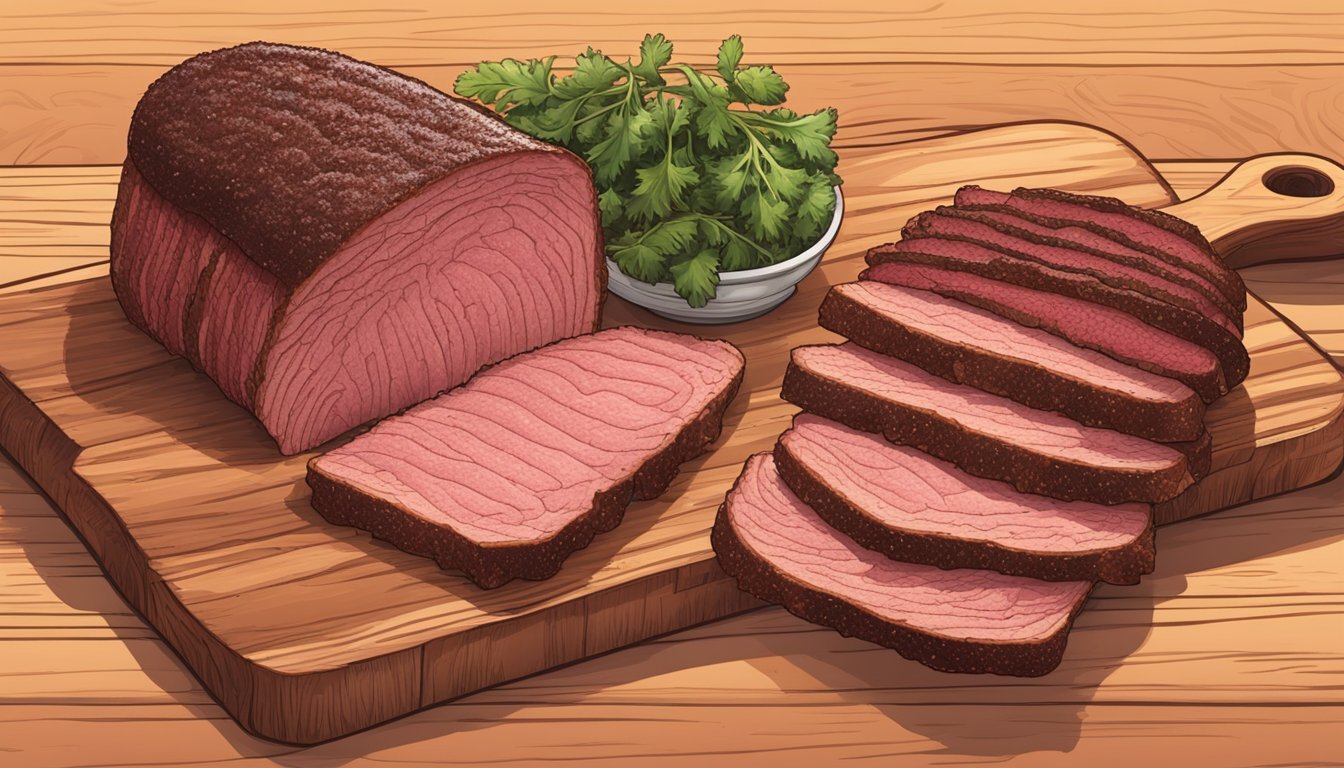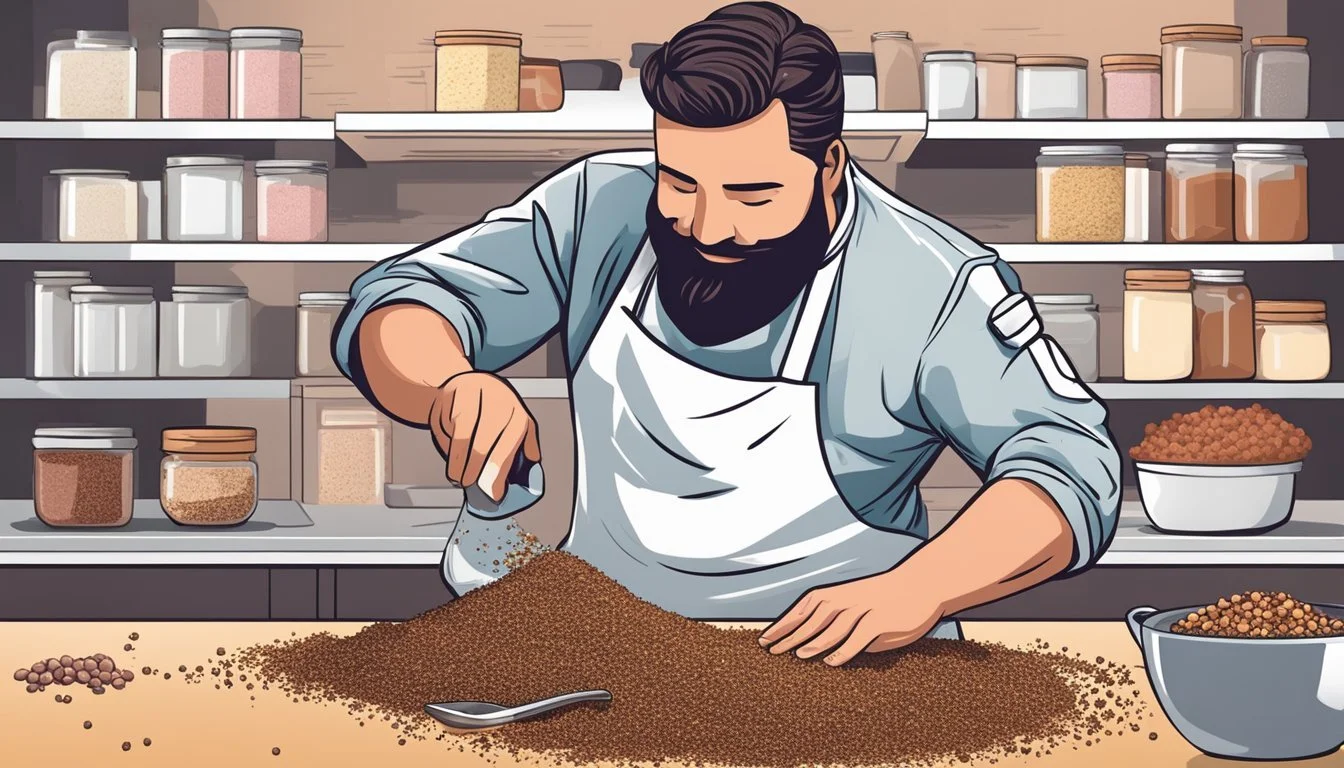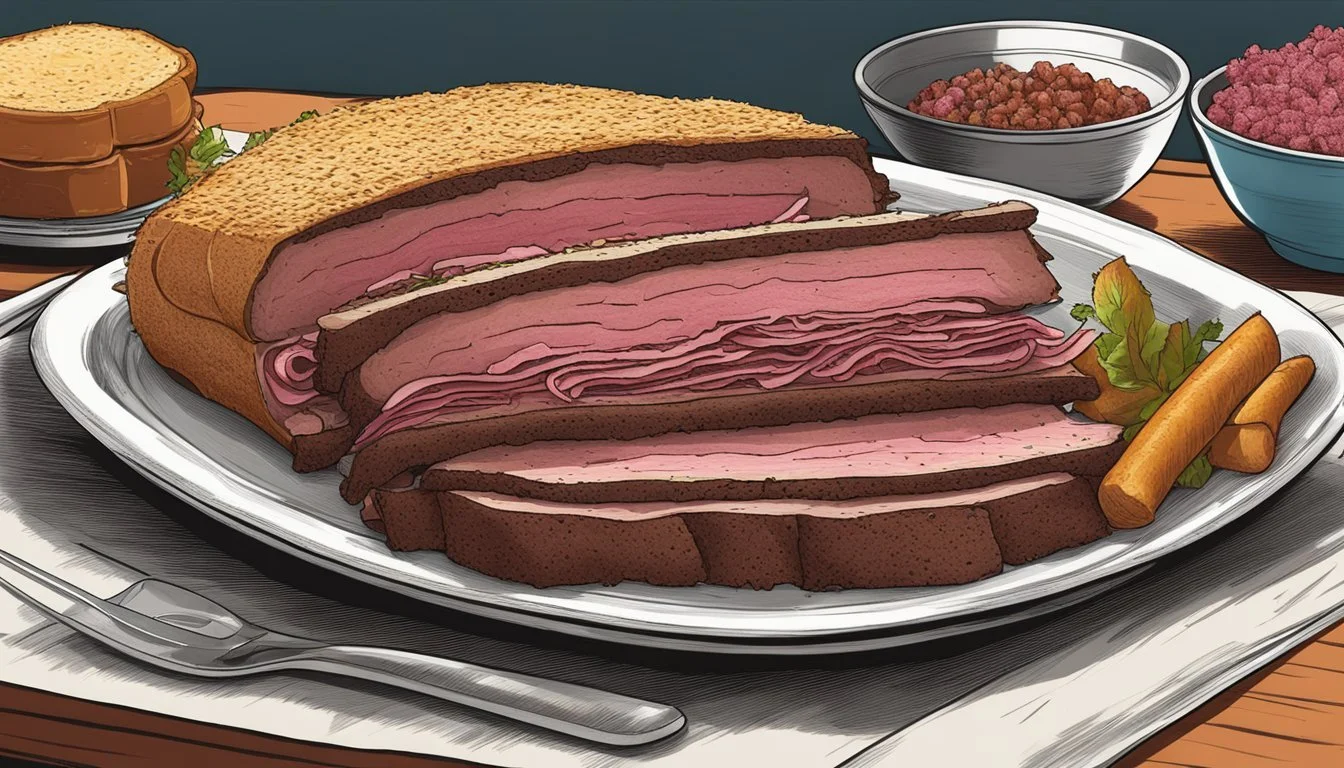Pastrami Rub, Beef Brisket, Corned Beef, Pastrami
Pastrami Rub, beef (What wine goes well with beef?) brisket, corned beef, and pastrami are terms frequently used in the culinary world, especially when discussing the art of preparing and consuming various cuts of meat. With roots tracing back to different cultures and cuisines, each of these terms represents specific techniques and flavors that contribute to the complexities of meat dishes enjoyed by many. This article aims to elucidate the qualities and characteristics that define each of these meat preparations.
At the core of these popular dishes lies beef brisket, (What wine goes well with beef brisket?) a cut of meat found in the lower chest area of the animal. This cut is known for its rich flavor and tough texture, requiring slow-cooking methods to tenderize it. One of the best ways to achieve this is by using a slow cooker and cooking the brisket for several hours in a mixture of cold water and cooking liquid, such as two cups of beef broth (how long does beef broth last?). The result is a piece of meat that is tender and flavorful.
Delving further into the world of brisket, two preparations deserving special attention are corned beef and pastrami - both derived from the same cut of meat, yet distinctly different in their flavor profiles and cooking methods. Corned beef gets its name from the large-grain salt, or "corns," used in the curing process. The cooking process involves cooking the brisket for several hours in a mixture of water, spices, and a seasoning packet. On the other hand, homemade pastrami is prepared through a combination of dry curing, smoking, and steaming. The use of a spice mixture, such as pastrami rub, which includes spices like black pepper, coriander, and garlic powder, (how long does garlic powder last?) distinguishes pastrami's unmistakable flavor and aroma. The cooking process for pastrami requires indirect heat for several hours until the meat is perfectly tender.
Understanding Pastrami
History and Origins
Pastrami has a rich history and strong connections to the culinary traditions of various cultures. Its origins can be traced back to the Romanian community, where a preserved, smoked, and spiced meat called "pastrama" was a popular dish. Romanian immigrants carried the technique to America in the late 19th century, where the modern-day pastrami emerged. Specifically, Jewish Romanians introduced the dish to New York City, where it quickly grew in popularity and became a staple of many delicatessens.
The process of preparing pastrami has evolved, with a key shift towards using beef brisket rather than the traditional sheep or lamb meat. This change occurred due to the cultural preferences of Jewish Americans and the availability of beef in the United States.
Pastrami vs Corned Beef
While pastrami shares some similarities with corned beef, they are distinct in several ways. The primary differences between pastrami and corned beef are the meat preparation and cooking methods.
Pastrami:
Raw Material: Beef Brisket
Curing Process: Dry Cure
Seasoning: Spice Rub
Cooking Method: Smoked
Corned Beef:
Raw Material: Beef Brisket
Curing Process: Wet Brine
Seasoning: Pickling Spices (how long does pickling spice last?)
Cooking Method: Boiled or Slow-cooked
Pastrami is typically made from beef brisket, which undergoes a dry cure with a mixture of salt, sugar, and curing salt. After the curing period, the meat is coated in a spice rub, commonly including black pepper, coriander, paprika, and garlic. The meat is then smoked, which adds a distinct flavor and tenderizes the meat. Finally, pastrami is usually sliced thin and served warm.
On the other hand, corned beef is a result of a wet brine curing process. Beef brisket is soaked in a salty solution with pickling spices, such as peppercorns, bay leaves, ginger, and mustard seeds (how long do mustard seeds last?). Once the curing period is complete, the meat is boiled or slow-cooked, either in water or with additional seasonings like beer. This cooking method helps achieve a tender, moist texture. Corned beef is typically served in thick slices or shredded, often accompanied by vegetables like cabbage and potatoes.
Pastrami and corned beef both owe their origins to preservation techniques that have been refined and adapted over time. Both flavorful and tender meat each offer unique takes on the art of curing and cooking beef brisket, and when it comes to cuts of beef that offer extra flavor and tenderness, few can match these two classics. Hours of cooking and careful attention to detail result in pastrami and corned beef that are melt-in-your-mouth tender, making them perfect for a wide range of dishes and culinary traditions.
Preparing the Meat
Selecting Quality Brisket
When preparing pastrami or corned beef, it all starts with selecting a quality beef brisket. Look for a brisket with a good amount of marbling, as this will contribute to the flavor and tenderness of the final product. A prime or choice-grade brisket is a good option for achieving great results. Check for a consistent thickness, ideally around 1.5 to 2 inches, to ensure even cooking.
Trimming and Tenderizing
Before seasoning the brisket, it's essential to trim off the excess fat. A thin layer of fat (about 1/4 inch) is ideal, as it will help to keep the meat moist during cooking. Use a sharp knife to carefully remove any thick areas of fat.
To tenderize the brisket, you have a few options:
Mechanical tenderization: You can use a meat mallet or a blade tenderizer to break down the meat's connective tissues and make it more tender. Be gentle during this process, avoiding over-tenderizing as that can compromise the meat's texture.
Marinade: Soaking the brisket in a marinade containing an acidic ingredient (such as vinegar or lemon juice) can help soften the meat. However, since pastrami and corned beef require specific brining processes, using a separate marinade may not be necessary.
Brining: Both pastrami and corned beef are often brined, which helps tenderize the meat and adds flavor. Given that, brining is an excellent technique to achieve a tender and flavorful brisket for these dishes.
Following these steps will help you prepare a delicious and tender brisket that can be further seasoned and cooked to create the perfect pastrami or corned beef dish.
I highly recommend purchasing a meat mallet or a blade tenderizer online for a convenient shopping experience!
Creating the Perfect Rub
Combining Spices
To create the perfect pastrami rub, it is crucial to select and combine the right spices. The most common ingredients found in a pastrami rub include:
Ground Black pepper
Coriander
Garlic powder
Onion powder (how long does onion powder last?)
Smoked paprika (how long does smoked paprika last?)
Yellow Mustard seeds (how long do yellow mustard seeds last?)
For an even and consistent flavor, it's necessary to use whole spices when possible. Start by getting whole coriander seeds (how long do coriander seeds last?) and black peppercorns (how long do black peppercorns last?). Using a spice grinder, grind them to a medium-fine consistency. The result should resemble a coarse powder.
If you can’t find these ingredients in your local markets, you can order black pepper, coriander, garlic powder, onion powder, smoked paprika, and yellow mustard seeds online!
If you're looking for a spice grinder, buying it online is your best bet!
Black pepper: 1/4 cup
Coriander: 1/4 cup
Garlic powder: 2 tbsp
Onion powder: 2 tbsp
Smoked paprika: 1 tbsp
Mustard seeds: 1 tbsp
The next step is to mix the ground spices with garlic powder, onion powder, smoked paprika, and mustard seeds. The ratios can be adjusted according to personal preference, but it's generally better to have equal parts black pepper and coriander. Combine all the ingredients in a bowl and mix them thoroughly. A well-blended pastrami rub enhances the overall flavor of the meat.
Applying the Rub
Once the spices are combined, it's time to apply the rub to the beef brisket or corned beef. First, pat the meat dry with paper towels to remove excess moisture. This step will allow the rub to adhere better to the surface. Next, apply a generous amount of the rub all over the meat, covering every nook and cranny. Make sure to press the spices onto the surface to help them stick.
As the rub sets onto the meat, it penetrates the fibers and infuses its delicious flavors. It's a good idea to let the rubbed meat rest in the refrigerator for at least a few hours, or ideally overnight, to allow the flavors to meld. Once the meat has been refrigerated, it's ready for smoking or cooking to transform it into delicious pastrami.
The Smoking Process
Setting Up Your Smoker
Before smoking your pastrami, beef brisket, or corned beef, it is essential to set up your smoker. Ensure it is clean and properly assembled. Fill the water pan and place it in the smoker to help maintain a consistent temperature. Preheat your smoker to a temperature of 225-250°F (107-121°C). Once the smoker is heated, add your choice of wood chips to the tray.
Wood Choices and Flavors
Selecting the right wood is crucial in achieving the desired flavor profile for your smoked meats (What wine goes well with smoked meats?). Here are some recommended wood choices for pastrami, beef brisket, and corned beef:
Cherry wood: imparts a mild, fruity flavor suitable for all types of meat.
Hickory: provides a medium-strong flavor that complements beef and pork cuts.
Mesquite: delivers a strong, earthy taste that works well with red meat.
Oak: offers a medium, balanced flavor suitable for larger cuts of meat.
Experiment with different wood combinations to find your preferred balance of flavors.
Smoking and Cooking Times
The smoking process depends on both the smoker's temperature and the meat's internal temperature. Use an instant-read thermometer to monitor these temperatures throughout the process.
Pastrami
Smoker Temp (°F): 225 - 250
Meat Finish Temp (°F): 190 - 205
Approx. Cooking Time: 1 - 1.5 hours/lb
Beef Brisket
Smoker Temp (°F): 225 - 250
Meat Finish Temp (°F): 200 - 205
Approx. Cooking Time: 1 - 1.5 hours/lb
Corned Beef
Smoker Temp (°F): 225 - 250
Meat Finish Temp (°F): 190 - 200
Approx. Cooking Time: 1 - 1.5 hours/lb
For successful smoking, maintain a consistent smoker temperature and cook the meat until it reaches the recommended internal temperature. Adjust the cooking times according to the meat's size and thickness. The key to achieving tender, flavorful meat is patience and a steady temperature throughout the process.
Serving and Enjoying Pastrami
Slicing and Serving
Proper slicing is an important element in serving and enjoying pastrami. First, make sure to use a sharp knife, as it helps achieve clean and thin slices. Pastrami should be sliced against the grain, which maximizes its tenderness. A typical serving size is around 4 to 6 ounces.
Here are a few suggested accompaniments for pastrami:
Rye bread: A classic choice, its robust flavor complements the pastrami well.
Pickles: Both dill (how long does dill last?) and sweet varieties can add a crunchy texture and tangy taste.
Mustard: Dijon or whole-grain mustard are popular choices to enhance the savory flavors.
Swiss cheese: A popular pairing, adding a creamy and slightly pungent taste.
Pastrami Sandwich Variations
Pastrami sandwiches offer endless possibilities for customization. Below are some popular variations:
Classic Pastrami Sandwich
Rye bread
Sliced pastrami
Swiss cheese
Mustard
Pastrami Reuben
Rye bread
Sliced pastrami
Swiss cheese
Thousand Island dressing
Pastrami Deli Melt
Rye bread
Sliced pastrami
Swiss cheese
Sauerkraut or coleslaw
Mayo or Thousand Island dressing
Pastrami Club
Three layers of sliced bread (rye or other)
Sliced pastrami
Swiss cheese
Lettuce
Tomato
Mayo
These variations showcase the versatility of pastrami sandwiches. Remember, the essentials are thinly sliced pastrami and bread, while additional ingredients can be customized to personal preferences.






